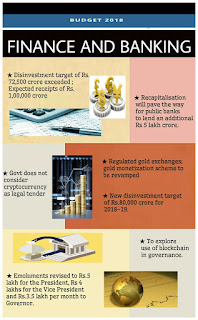Budget Series : Finance and Banking
With no big bang announcements on the Budget day, the banking sector had to be satisfied with what they already have. In fact, were given a bigger task to provide incremental loans worth Rs 5 lakh crore in Fy19.
The proposal to allow RRBs to raise market capital would enable these institutions to support credit flow to the rural sector. The proposals to review the refinancing norms for NBFCs(Non-Banking Financial Company) under MUDRA and receivable discounting by PSBs would improve credit supply to MSMEs and support the credit growth of banks and NBFCs. The increase in exempted interest income is unlikely to significantly improve deposit base, as the tax exemption is restricted to senior citizens who anyways prefer bank deposits. However, the proposal to provide insurance and pension benefits to the poor through Jan Dhan accounts can improve the deposit base of banks to some extent.
The big expected announcement which didn’t come was the increase in foreign holding limit in private sector lenders from the present 74%. Stocks of private sector banks had run up sharply. The budget reiterated its commitment to bank recapitalization but was numb on any more reforms.Bank recapitalisation program has been launched with bonds of Rs 80,000 crore being issued this year. The programme has been integrated with an ambitious reform agenda, under the rubric of an Enhanced Access and Service Excellence (EASE) programme. This recapitalisation will pave the way for the public sector banks to lend additional credit of Rs 5 lakh crore.
There were also no new big announcements with regards to the resolution of non-performing assets (NPAs) which the banking sector is currently struggling to deal with.
In the absence of any big announcements, bank shares lagged with the BSE Bankex closing in the red.
So, overall the banking sector will have no prominent effect from the announcements made regarding the finance sector but there will be repercussions arising from the reforms and strategies of the other sectors. Affordable housing in rural areas would also add to retail loan growth of both banks and non-banking financial companies. The 10% hike in agriculture credit to Rs 11 lakh crore and the proposal to hike the minimum support prices of all crops at 1.5X of production costs augur well for rural incomes and spending. This should benefit banks through improved credit offtake as well as an improvement in asset quality in the agriculture segment.
Despite dismissing the consideration of crypto-currencies as legal tender or coin and warning of all measures to eliminate use of these crypto-assets in financing illegitimate activities or as part of the payment system, the Government will explore use of blockchain technology proactively for ushering in digital economy.
The government has, for the first time in India’s history, beaten its own disinvestment target, raising about Rs 92,000 crore by selling its stake in state run companies as against the budgeted Rs 72,500 crore.
Though buoyed by the success of its disinvestment policy, the government raised the target for 2018-19 by a modest 10.3% year-on-year to Rs 80,000 crore.
Though buoyed by the success of its disinvestment policy, the government raised the target for 2018-19 by a modest 10.3% year-on-year to Rs 80,000 crore.
CREDITS : POOJA

Comments
Post a Comment